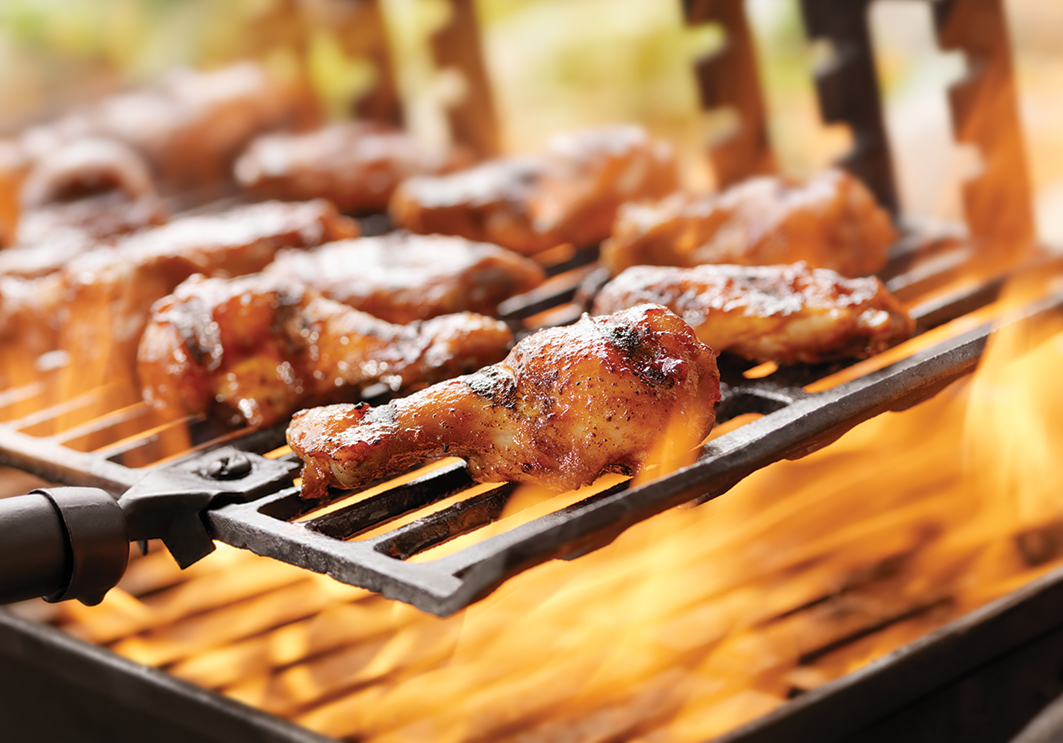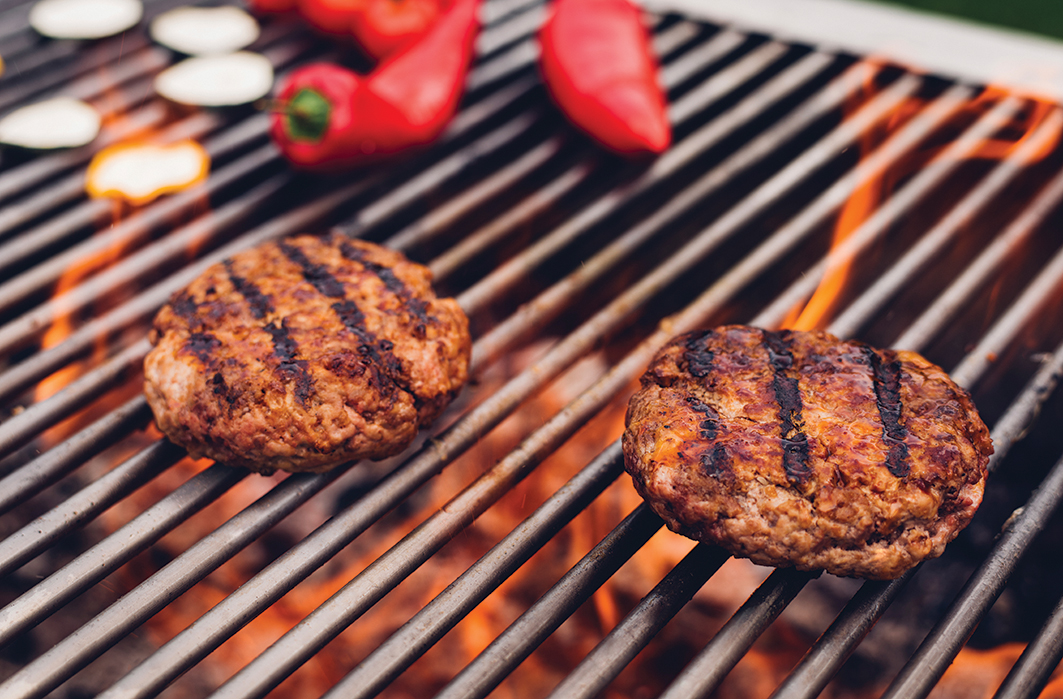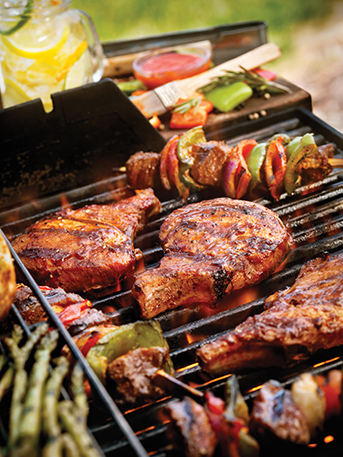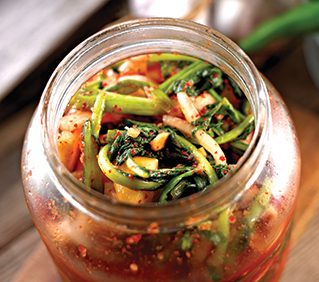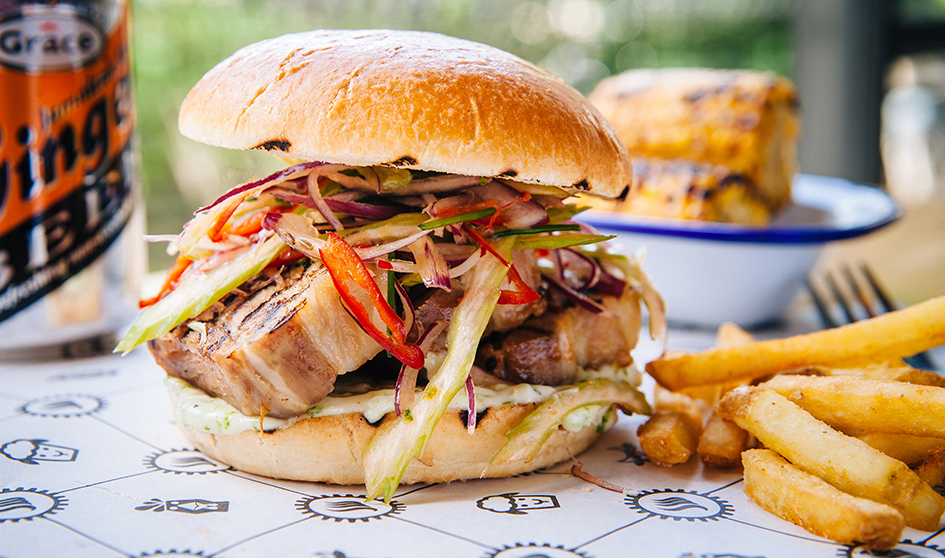The perfect barbecue is down to the right food, fuel and the grill that you choose. Andrew Webb has some advice
Meat, meet fire. This incredible event in human history is thought to have taken place around one million years ago. Why? Well, cooking meat makes it easier to chew and digest, as well as making it safer to eat. But more than that, it makes meat tasty, darn tasty. Then, as cooking came first indoors, and then into an oven, we lost the skills of cooking outside over naked flames using solid fuel. Today, all that’s left is the barbecue.
When I was growing up, barbecues in Britain were often dreadful testosterone and alcohol-fuelled affairs. We had neither the equipment nor the experience to do them properly, resulting in the classic ‘burned on the outside, raw in the middle’ chicken drumstick. I’ve got dozens of British cookery books from the latter half of the 20th century and not one of them mentions cooking outside on a barbecue.
In the past five years there’s been an explosion of ‘dude food’ and the American style of outdoor cooking. They’re not the only nation with a culture of outdoor cooking over coals however. South America, Australia, southern Asia and the Caribbean all have variations, as does the eastern Mediterranean and Middle East with their kebabs and koftas.
What is barbecue?
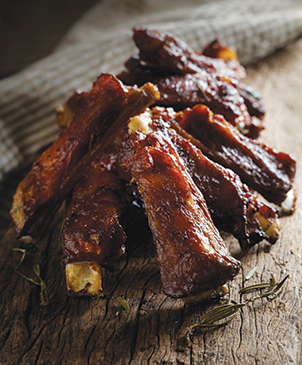
This question will get you a different answer, and even different spelling, depending on whom you ask. So perhaps I’ll leave it to the late, great food writer and founder of the Meatopia festival, Josh Ozersky, who once said, “the only ingredients that truly matter in barbecuing – beyond the quality of the meat, of course – are smoke and time.” Barbecue boils down to one of two methods, either high temperature and short time, or low temperature and a long time. In the UK, we tend to favour what Americans call grilling. This means smaller items like burgers, steaks and sausages cooked directly and quickly over hot coals and the occasional flame. If you’re going to cook steaks, bigger, thicker ones work much better as they allow time for that lovely telltale charred crust to form on the outside, without completely overcooking the centre. You can also cook steaks ‘dirty’, which means throwing them directly onto the hot coals. Proper barbecuing is cooking large cuts of meat much slower, often indirectly. This means the coals are moved to one side of the barbecue and the resulting gentle radiant heat as well as smoke does all the work. Using this ‘low’ (as in temperature) and ‘slow’ (as in it takes a while) approach, you can cook meat with lots of connective tissue such as shoulder and brisket, breaking it down for a soft and delicious result.
Kit
The cheapest way to cook outdoors is to dig a small hole in the ground, line it with rocks and fill it with fuel. Great if you’ve got the space, but a little tricky in a tiny back garden off Mill Road. Barbecues come in all shapes and sizes, but whichever one you choose, do look for one with a lid, so you can smoke and cook indirectly. The last word when it comes to buying a barbecue, however, has to go to Big Green Egg (pictured below, right). These ceramic barbecues are brilliant; you can grill on them, but also slow-cook meats and roast chickens.
“Look for one with a lid, so you can smoke indirectly”
With the addition of a pizza stone you can even cook pizzas and bread on them. Gog Magog Farm Shop has a full range and hosts courses showing you how to get the most out of one, with Nic Williams from Big Green Egg. As Nic says: “There are only two accessories you need to barbecue all year round, an umbrella and a glass of wine!”
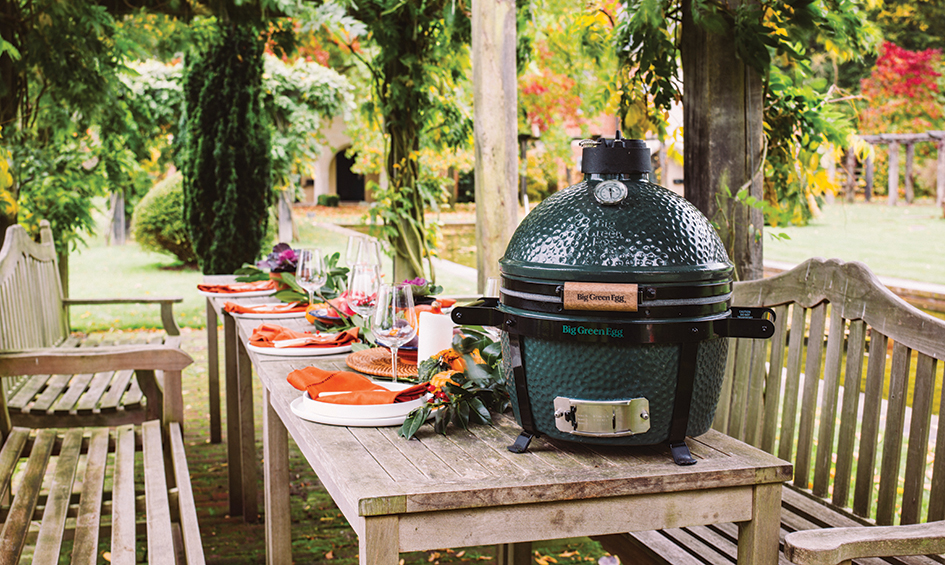
Nick Williams’ top five barbecue tips
1. Start with the best ingredients and that includes the charcoal. Make friends with your butcher and get them to advise you on what cuts of meat to cook.
2. Do one thing and do it well. A marinated butterflied leg of lamb is a good start.
3. After cooking your meat, rest it – whether it’s a steak or a whole shoulder of pork. It will relax the meat and make it more succulent.
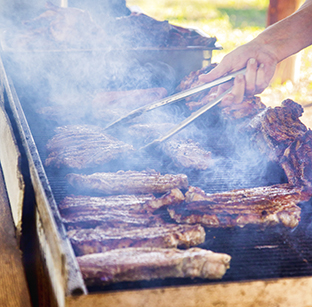
4. Relax, give yourself time. A barbecue with a lid will allow you to control the temperature, and get it going early.
5. Buy a Big Green Egg, it’s the best way to cook outside. Just ask the more than 30 Michelin-starred restaurants who use them!
Big Green Egg courses
15 June – Technique & Surfaces
20 July – Spanish Dishes
17 August – Get Creative
7 December – Christmas
14 December – Christmas
See gogmagoghills.com/events
Fuel
The type of fuel you use on your barbecue is actually really important. Charcoal comes in two main types: lump and briquettes. Lump charcoal is made from burning solid wood in a reduced oxygen atmosphere. It burns quickly and gets hot fast, though after that it cools rapidly. This is great for quickly grilling things like steaks and sausages. You can also use wood for indirect smoking to give a lovely smoky flavour. Briquettes are made from charcoal and coal dust held together with a starch binder. The advantage of these is their uniform size and shape, and the fact that they burn for longer. They’re often cheaper too. However they also produce more ash than lump charcoal. Whichever you decide to use, I’d avoid anything that’s impregnated with chemicals that help it set alight.
As well as from the national DIY and garden centres such as Scotsdales in the region, you can also get fuel for your barbecue from Forestry Fuels in St Neots, Treewood Charcoal in Bishop’s Stortford, and further afield, the excellent Oxford Charcoal Company.
Fire starter
I don’t like firelighters, lighter fluid or other chemicals to get a barbecue started. It’s far better to buy a chimney starter, now widely stocked alongside barbecues. This ingenious invention consists of a small metal barrel with holes in the bottom; you simply place the charcoal inside and the holes draw air in and up through it. Place some newspaper underneath the coals, light them, and 15 minutes later the coals are ready. You then just pick up the chimney starter and tip the coals out onto the rest of the barbecue.
Cook savvy
Now, I love a good steak, or a chop; as well as a juicy burger or a smoky hot dog. I love all these things, just not all at once on the same plate. There’s the tendency with many barbecue menus to have too much food, often from all over the globe. A South American style menu isn’t going to sit well alongside Middle Eastern dishes. The flavours will muddle and much like mixing all the colours together, you get brown. So pick a country or region and think about the dishes from there.
All too often I see cooks at the grill constantly pressing burgers or other meats down with the spatula, the result is a flare-up of flame and a satisfying sizzle. The trouble is, all you’re doing is squeezing out the lovely juices from your meat. This means a dry burger, with much of the flavour now coating the coals underneath, so remember: don’t squeeze your meat!
Slather on the sauce
The sides and sauces to served alongside your meat are critical. You don’t want chimichurri, peri peri and kimchi all on the same plate. If you’ve not heard of any of these sauces, and still reach for the tomato ketchup, here’s all you need to know.
Chimichurri is an Argentinian sauce made from finely-chopped parsley, garlic, oil, oregano and white vinegar. It’s best served with thick slices of steak and a large glass of red. Peri peri is originally from Portugal via the trade routes of Africa, and features chilli, lemon juice, herbs and oil. It can be used both as a sauce and a marinade for meats such as chicken (never serve a sauce that raw meat has been marinated in though). Kimchi meanwhile is a pungent Korean sauce made from chilli and pickled vegetables, often shredded cabbage. It’s great on anything from rice to burgers. If you’re sticking with US style sauces, they’re mainly tomato and vinegar based, with sweetness from brown sugar or molasses.
Smokeworks
If all this sounds like too much effort, then let someone else do all the work for you.
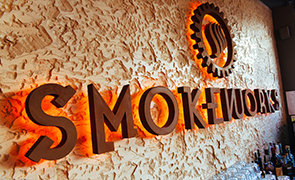
For an event or larger party, there’s The Cambridge Barbecue Company. They’ll arrive, light the coals, do all the cooking, and clean up afterwards. They can tailor a menu to your exact tastes and preferences, as well as budget. For eating barbecue out and about in Cambridge, there’s SmokeWorks on Free School Lane. Here chef Vladimir Hromek and his team offer the ultimate in low ’n’ slow barbecue. I asked him for his barbecue advice.
What’s your top barbecue tip?
“It’s all about understanding the ingredients and the cooking equipment – smoke and fire are not as precise as gas and electricity.”
What’s the key to making your iconic pork belly bun a success?
“Tenderness and smoke on the pork belly is the key – we slow roast the pork for three hours so it has that melt-in-the-mouth tenderness.”
What’s the secret to a great home-made barbecue sauce?
“Try as many recipes as you can find and see what you prefer. There are so many varieties. It really is only about your personal preference. At SmokeWorks we experimented for months before settling on our own recipe, which uses apricots and apple juice. These natural fruit juices give the sauce a great fruity tang and help with the glazing process on the ribs.”
What do you do differently to other barbecue chefs?
“I don’t ask myself such questions. I try to input as much passion and love into our food as humanly possible. That is the only rule!”
RECIPE: Pork Belly Bun – Asian Slaw and Lime Mayo
Serves 4: easy-medium difficulty
Marinated Pork Belly
- 700-800g pork belly
- 50ml Shaoxing rice wine
- 50g light brown sugar
- 50ml light soy sauce
Asian Slaw
- 1/2 red onion
- 1 stick of celery
- 2 green chillies
- 8 mangetout
- 2tbsp fresh coriander
- 1tbsp toasted sesame oil
- 1tbsp sesame seeds
- 1 lime (zest & juice)
Lime Mayo
- 5tbsp mayonnaise
- 1 lime (zest & juice)
- pinch of salt
Assembly
- 4 brioche buns
To prepare the marinated pork belly
The day before, cut the pork belly into six equal rectangles. Mix together the rice wine, sugar and soy sauce until the sugar has dissolved. Pour the marinade over the pork belly, massage it gently into the meat and leave it to marinate overnight in the fridge.
The next day preheat the oven to 150°C/130°C fan/gas mark 2. Place the pork belly in a small roasting tray and pour over all the juices. Cover with foil and slow roast the pork for three hours until very tender. Leave to cool, setting aside the cooking juices for later.
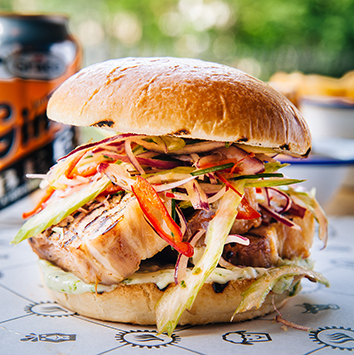
To Make the Asian Slaw
Thinly slice the red onion, celery, green chillies and mangetout. Combine in a bowl with the fresh coriander, sesame oil, sesame seeds, lime zest and juice. Leave to marinate for one hour.
To Make the Lime Mayo
Mix together the mayonnaise, lime zest, lime juice and a pinch of salt.
To Assemble
Cut each rectangle of pork belly in half to make 12 squares. Heat a griddle pan to medium-hot. Grill each square of pork belly on both sides for 30 seconds. Spread the lime mayo on the inside of each bun. Fill each bun with three squares of grilled pork belly. Place a heaped spoon of Asian slaw on top of the belly and drizzle with a little of the reserved cooking juices. Cover with the brioche bun lid and serve.
Recipe from Vladimir Hromek, head chef at SmokeWorks
2 Free School Lane, CB2 3QA www.smokeworks.co.uk
A final word
Avoid those cheap disposable barbecues. They can’t cook much more than a sausage. Not only that, but they damage the grass, so much so that Cambridge City Council has banned barbecuing in public spaces. However, recognising that people love to barbecue, they’ve installed barbecue stones at Jesus Green and a designated area located at Sheep’s Green/Lammas Land and Byron’s Pool. Enjoy!
Andrew Webb’s new book, the Haynes Meat Manual, was released last month.

